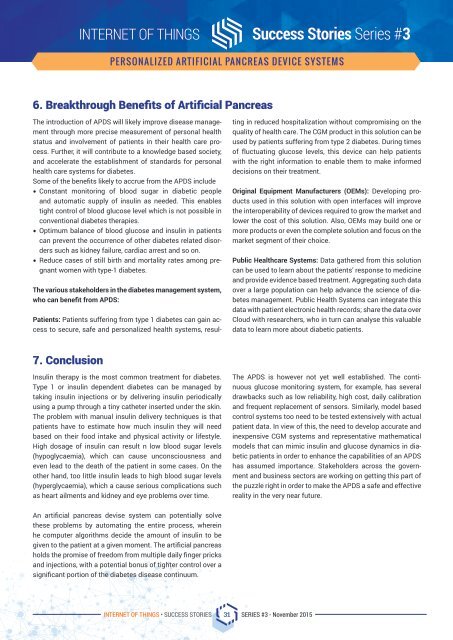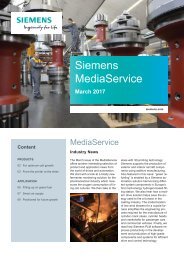Success Stories
VEZSJ
VEZSJ
You also want an ePaper? Increase the reach of your titles
YUMPU automatically turns print PDFs into web optimized ePapers that Google loves.
Internet of Things <strong>Success</strong> <strong>Stories</strong> Series #3<br />
Personalized Artificial Pancreas Device Systems<br />
6. Breakthrough Benefits of Artificial Pancreas<br />
The introduction of APDS will likely improve disease management<br />
through more precise measurement of personal health<br />
status and involvement of patients in their health care process.<br />
Further, it will contribute to a knowledge based society,<br />
and accelerate the establishment of standards for personal<br />
health care systems for diabetes.<br />
Some of the benefits likely to accrue from the APDS include<br />
• Constant monitoring of blood sugar in diabetic people<br />
and automatic supply of insulin as needed. This enables<br />
tight control of blood glucose level which is not possible in<br />
conventional diabetes therapies.<br />
• Optimum balance of blood glucose and insulin in patients<br />
can prevent the occurrence of other diabetes related disorders<br />
such as kidney failure, cardiac arrest and so on.<br />
• Reduce cases of still birth and mortality rates among pregnant<br />
women with type-1 diabetes.<br />
The various stakeholders in the diabetes management system,<br />
who can benefit from APDS:<br />
Patients: Patients suffering from type 1 diabetes can gain access<br />
to secure, safe and personalized health systems, resulting<br />
in reduced hospitalization without compromising on the<br />
quality of health care. The CGM product in this solution can be<br />
used by patients suffering from type 2 diabetes. During times<br />
of fluctuating glucose levels, this device can help patients<br />
with the right information to enable them to make informed<br />
decisions on their treatment.<br />
Original Equipment Manufacturers (OEMs): Developing products<br />
used in this solution with open interfaces will improve<br />
the interoperability of devices required to grow the market and<br />
lower the cost of this solution. Also, OEMs may build one or<br />
more products or even the complete solution and focus on the<br />
market segment of their choice.<br />
Public Healthcare Systems: Data gathered from this solution<br />
can be used to learn about the patients’ response to medicine<br />
and provide evidence based treatment. Aggregating such data<br />
over a large population can help advance the science of diabetes<br />
management. Public Health Systems can integrate this<br />
data with patient electronic health records; share the data over<br />
Cloud with researchers, who in turn can analyse this valuable<br />
data to learn more about diabetic patients.<br />
7. Conclusion<br />
Insulin therapy is the most common treatment for diabetes.<br />
Type 1 or insulin dependent diabetes can be managed by<br />
taking insulin injections or by delivering insulin periodically<br />
using a pump through a tiny catheter inserted under the skin.<br />
The problem with manual insulin delivery techniques is that<br />
patients have to estimate how much insulin they will need<br />
based on their food intake and physical activity or lifestyle.<br />
High dosage of insulin can result n low blood sugar levels<br />
(hypoglycaemia), which can cause unconsciousness and<br />
even lead to the death of the patient in some cases. On the<br />
other hand, too little insulin leads to high blood sugar levels<br />
(hyperglycaemia), which a cause serious complications such<br />
as heart ailments and kidney and eye problems over time.<br />
The APDS is however not yet well established. The continuous<br />
glucose monitoring system, for example, has several<br />
drawbacks such as low reliability, high cost, daily calibration<br />
and frequent replacement of sensors. Similarly, model based<br />
control systems too need to be tested extensively with actual<br />
patient data. In view of this, the need to develop accurate and<br />
inexpensive CGM systems and representative mathematical<br />
models that can mimic insulin and glucose dynamics in diabetic<br />
patients in order to enhance the capabilities of an APDS<br />
has assumed importance. Stakeholders across the government<br />
and business sectors are working on getting this part of<br />
the puzzle right in order to make the APDS a safe and effective<br />
reality in the very near future.<br />
An artificial pancreas devise system can potentially solve<br />
these problems by automating the entire process, wherein<br />
he computer algorithms decide the amount of insulin to be<br />
given to the patient at a given moment. The artificial pancreas<br />
holds the promise of freedom from multiple daily finger pricks<br />
and injections, with a potential bonus of tighter control over a<br />
significant portion of the diabetes disease continuum.<br />
Internet of Things • <strong>Success</strong> <strong>Stories</strong> 31 SERIES #3 - November 2015









